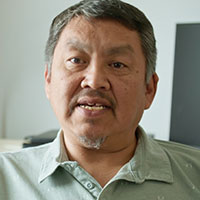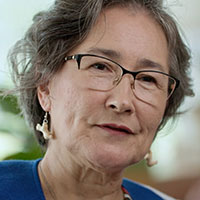Filmed over three years, Nunatta Ataani (Beneath Our Feet) explores the history, inner workings, and contemporary challenges of the mining industry in Nunavik. Revolving around Inuit voices, the film sheds light on their perspectives regarding the economic, environmental, and cultural impacts of this rapidly expanding industry.
The region's mineral potential has drawn attention from our governments and companies around the globe. Now, more than ever, people are eager to understand this evolving industry. Through interviews with workers, industry leaders, elected officials, and experts, Nunatta Ataani skillfully traces the history of this industry in northern Quebec, demystifying its complex operations while highlighting the impacts of current development.
By exploring the region's mining history and visiting various projects, from early prospecting to fully operational mines, the film addresses crucial topics such as royalties, environmental concerns, and coexistence with Nunavimmiut. This documentary is a must-watch for anyone seeking to better understand this often-overlooked industry and to gain an informed perspective on the challenges it presents.
One of the key missions of the NMEF, producer of the film, is to raise awareness of mining exploration among Inuit communities through workshops and field training. They educate on local industry projects and help companies navigate working with Inuit communities from both cultural and technical perspectives, bridging the gap between them. Wanting to reach a broader audience and provide an inside look into the industry, the Nunavik Mining Exploration Fund decided to produce a film.
Indeed, the mining industry remains a mystery to many, both in Nunavik and across Canada, and its complex history often fosters suspicion. This is why, in collaboration with Ubique Film, we chose the documentary format as the best way to deliver a transparent and informative perspective on mining in Nunavik.
The film focuses on three key themes: history, education, and giving a voice to the community. It addresses the past, present, and future of the mining industry from cultural, sociological, economic, and environmental perspectives. At the heart of the film is the desire to educate about the basic ins and out of the mining industry and the impact, positive or less, on the life of the Inuit.
By interviewing elders, like Johnny May & Charlie Watt we go back to the early days of prospecting all the way to the James Bay and Northern Quebec Agreement and landmark agreement like the Raglan Agreement.
We contextualize how the industry arrived here and the kind of impact it had and how it fits in Nunavik’s recent history. Some stories have more personal or human implications (Jeeka Kudluk, Annie Sakiagak) while others are crucial to understand where and why we are here in 2024.
In the field, we visit different prospecting projects at various stages of their development, to learn about the steps involve in the mining development and the overall region potential. We demystify the workings of today’s industry: how claims work, the stages of mining development, laws and rules at play, royalties, environmental standards, organizations and governments involved. We visit both Raglan and Nunavik Nickel, the two current actives mines in Nunavik, to meet with Inuit employees and learn about their jobs but also to interview management about their commitment toward employment, the environment and community relationship.
Throughout the film, we give voice to Inuit employees, politicians, and citizens to express their hopes and concerns about about an industry that already shapes many lives and is set to play a major role in the future.

"The mining industry will come whether we like it or not. (..) Are we going to be observers like we have been for many decades? Or are we going to be the ones dictating in how our region is being accessed? "

"As someone who would like to see our environment remain as clean and pure as possible, it's difficult to say no to mining development projects that actually bring financial revenues of sorts. (…) Though, the economic aspect of mining can be beneficial to the communities, there's also a long-term negative impact on Inuit way of life."

"I don't think every mining project is created equally. There are certain types of mining maybe we're going to try and stay away from. But it's an opportunity we've been given as a living in Nunavik."

"My husband worked for the prospectors looking for ore while I did the laundry for the white people. I would spend the whole day washing their clothes. In the 2 years I worked, I received just 2 dollars. "

"Before the James Bay agreement, there was really no services at that time. It's only when they [the government] started finding out what potential there was for Nunavik in terms of the minerals, the waters. So only when they saw something, that's when they started being here."

"The Nunavik territory always been considered as a underexplored area. There's a high potential of finding mineral resources. Before, there was on an annual basis about 20,000 to 25,000 claims being designated in Nunavik. And last year we counted about 50,000. So exploration activities has been doubled."
For additional information, media inquiries, or interview requests, please contact Véronique Gagnon at press@nunattaataani.com
Interested in sharing the film? You can share this page on Facebook or share the full movie on your website using the YouTube embed code by clicking here to copy the embed code.
For more information about the Nunavik Mineral Exploration Fund, visit our website here.
